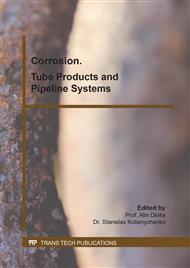p.36
p.42
p.48
p.54
p.60
p.66
p.72
p.78
p.84
Development of Polymer-Based Composite Coatings for the Gas Exploration Industry: Polyoxometalate Doped Conducting Polymer Based Self-Healing Pigment for Polymer Coatings
Abstract:
This study deals with the evaluation of self-healing ability of conducting polymer corresponding to a corrosion process. Poly ortho-anisidine (PoA) was doped with Phosphomolybdic acid (PMA) and Tungstosilicic acid (TSA) and incorporated in polyvinyl butyral (PVB) coatings. The self-healing abilities of coatings were evaluated using open circuit potential (OCP) in 0.1 M NaCl solution for 45 hours of immersion. The coatings containing doped PoA showed increased positive potential of OCP after 45 hours of immersion as compare toblank PVB which showed a constant profile of OCP over the time indicating uniform corrosion under the coating.Thermogravimetric analysis (TGA) showed that PoA doped with TSA is more stable and more effective in the coating. High resolution Transmission Electron microscopy (HR-TEM) and Energy dispersive x-ray spectroscopy (EDX) confirms the doping of PoA.
Info:
Periodical:
Pages:
60-65
Citation:
Online since:
November 2016
Authors:
Price:
Сopyright:
© 2017 Trans Tech Publications Ltd. All Rights Reserved
Share:
Citation:



